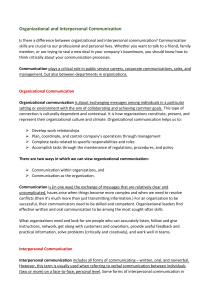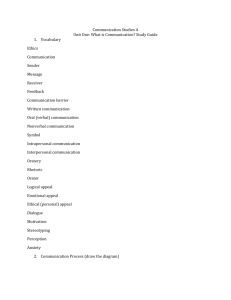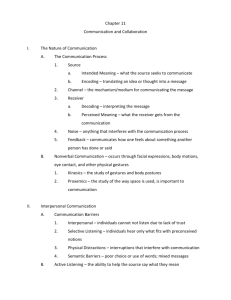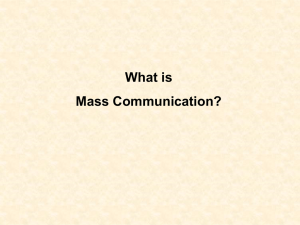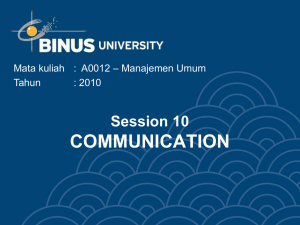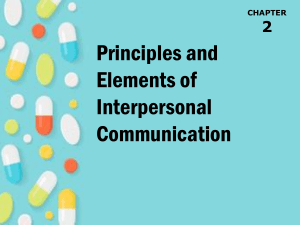Interpersonal communication
advertisement
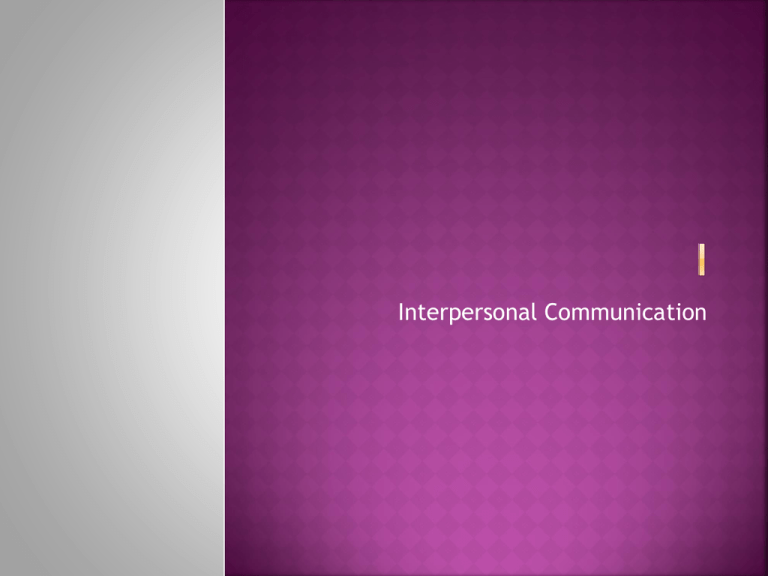
Interpersonal Communication How we create and exchange messages with others. What are some ways we do this? What are the pros and cons of each method? Make a T-chart as we discuss. Linear: Message flows in one direction from a sender to a receiver. In all interpersonal communication models, there is always noise; meaning factors that can impede the message from being received. Interactive: There is a sender and receiver, but there are two additional factors influencing the transmission—feedback (verbal and nonverbal) and fields of experience. If field of experience is similar the ease of understanding is better. Transactional: communication is fundamentally multidirectional. The messages are exchanged through channels, jointly creating meaning. Each person equally influences the conversation. There is no perceived sender or receiver. Most interpersonal communication is transactional Impacts our relationships. It changes thoughts, behaviors, emotions, and relationships. How? Is any communication NOT interpersonal? I-thou competent communication welcoming respectful I-it Focuses on personal differences Refuses to accept the other’s opinions as valid Creates a distance Views the other as an object to exploit Becomes disrespectful and manipulative as it worsens, and relationship deteriorates Think of someone you have I-it relationship. Identify the qualities that cause you to see this person as different from or inferior to you. Are these differences a cause for concern? What similarities do you share with this person? How can you communicate with this person in ways that accept and respect differences while appreciating and emphasizing similarities? Conveys: Content information-actual meaning of the words Relationship information- indicates how each person views the relationship Role Play some examples of how this works Ex. Do you think you can rinse your dishes and put them in the dishwasher when you are finished with them? Many ways tone can be uses with the word “no” This can create problems when perception of sender in situation is different from the receiver. How can we assure we are not sending a different message than intended? Communication about how we communicate It is any message that includes information, both verbal and non-verbal, that is centrally focused on the meaning of the communication. It is about how the information is perceived. Can be Intentional Unintentional People tend to attach meaning to nearly everything you say and do. It is impossible to not communicate. For instance—Contact lens story Is irreversable Even how you answer your phone effects the rest of the conversation and can change the relationship. Once it is said, you cannot take it back- Facebook posts Texts Voicemails Instagram Spoken thoughts Think before you communicate! Is dynamic When you interact with others, your communication and all that influences it (perceptions, thoughts, feelings, and emotions) is constantly in flux. The complex combination of perceptions, thoughts, moods, and emotions that fuel communication choices is constantly changing. For instance, you are overjoyed to see someone and then a few minutes later, you have nothing to say to each other. Helen Keller Became blind and deaf at 19 months old When she couldn’t hear, she stopped trying to talk Felt isolated and frustrated. She said she became a phantom. That phantom threw temper tantrums and even punched her teacher in the mouth. She learned sign language and began to feel a sense of returning thought It is a profound human need to communicate How does interpersonal communication assist people in pursuing higher needs? Self presentation goals-helps you to determine how you are perceived Instrumental goals-practical aims you want to achieve or tasks you want to accomplish through a particular interpersonal encounter Relationship goals-building, maintaining, or terminating bonds with others.

